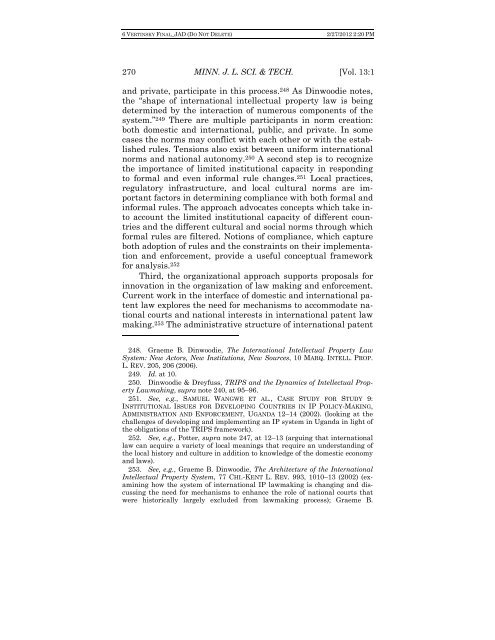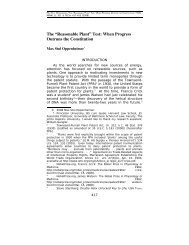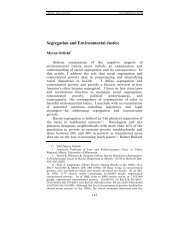An Organizational Approach to the Design of Patent Law
An Organizational Approach to the Design of Patent Law
An Organizational Approach to the Design of Patent Law
Create successful ePaper yourself
Turn your PDF publications into a flip-book with our unique Google optimized e-Paper software.
6 VERTINSKY FINAL_JAD (DO NOT DELETE) 2/27/2012 2:20 PM<br />
270 MINN. J. L. SCI. & TECH. [Vol. 13:1<br />
and private, participate in this process. 248 As Dinwoodie notes,<br />
<strong>the</strong> “shape <strong>of</strong> international intellectual property law is being<br />
determined by <strong>the</strong> interaction <strong>of</strong> numerous components <strong>of</strong> <strong>the</strong><br />
system.” 249 There are multiple participants in norm creation:<br />
both domestic and international, public, and private. In some<br />
cases <strong>the</strong> norms may conflict with each o<strong>the</strong>r or with <strong>the</strong> established<br />
rules. Tensions also exist between uniform international<br />
norms and national au<strong>to</strong>nomy. 250 A second step is <strong>to</strong> recognize<br />
<strong>the</strong> importance <strong>of</strong> limited institutional capacity in responding<br />
<strong>to</strong> formal and even informal rule changes. 251 Local practices,<br />
regula<strong>to</strong>ry infrastructure, and local cultural norms are important<br />
fac<strong>to</strong>rs in determining compliance with both formal and<br />
informal rules. The approach advocates concepts which take in<strong>to</strong><br />
account <strong>the</strong> limited institutional capacity <strong>of</strong> different countries<br />
and <strong>the</strong> different cultural and social norms through which<br />
formal rules are filtered. Notions <strong>of</strong> compliance, which capture<br />
both adoption <strong>of</strong> rules and <strong>the</strong> constraints on <strong>the</strong>ir implementation<br />
and enforcement, provide a useful conceptual framework<br />
for analysis. 252<br />
Third, <strong>the</strong> organizational approach supports proposals for<br />
innovation in <strong>the</strong> organization <strong>of</strong> law making and enforcement.<br />
Current work in <strong>the</strong> interface <strong>of</strong> domestic and international patent<br />
law explores <strong>the</strong> need for mechanisms <strong>to</strong> accommodate national<br />
courts and national interests in international patent law<br />
making. 253 The administrative structure <strong>of</strong> international patent<br />
248. Graeme B. Dinwoodie, The International Intellectual Property <strong>Law</strong><br />
System: New Ac<strong>to</strong>rs, New Institutions, New Sources, 10 MARQ. INTELL. PROP.<br />
L. REV. 205, 206 (2006).<br />
249. Id. at 10.<br />
250. Dinwoodie & Dreyfuss, TRIPS and <strong>the</strong> Dynamics <strong>of</strong> Intellectual Property<br />
<strong>Law</strong>making, supra note 240, at 95–96.<br />
251. See, e.g., SAMUEL WANGWE ET AL., CASE STUDY FOR STUDY 9:<br />
INSTITUTIONAL ISSUES FOR DEVELOPING COUNTRIES IN IP POLICY-MAKING,<br />
ADMINISTRATION AND ENFORCEMENT, UGANDA 12–14 (2002). (looking at <strong>the</strong><br />
challenges <strong>of</strong> developing and implementing an IP system in Uganda in light <strong>of</strong><br />
<strong>the</strong> obligations <strong>of</strong> <strong>the</strong> TRIPS framework).<br />
252. See, e.g., Potter, supra note 247, at 12–13 (arguing that international<br />
law can acquire a variety <strong>of</strong> local meanings that require an understanding <strong>of</strong><br />
<strong>the</strong> local his<strong>to</strong>ry and culture in addition <strong>to</strong> knowledge <strong>of</strong> <strong>the</strong> domestic economy<br />
and laws).<br />
253. See, e.g., Graeme B. Dinwoodie, The Architecture <strong>of</strong> <strong>the</strong> International<br />
Intellectual Property System, 77 CHI.-KENT L. REV. 993, 1010–13 (2002) (examining<br />
how <strong>the</strong> system <strong>of</strong> international IP lawmaking is changing and discussing<br />
<strong>the</strong> need for mechanisms <strong>to</strong> enhance <strong>the</strong> role <strong>of</strong> national courts that<br />
were his<strong>to</strong>rically largely excluded from lawmaking process); Graeme B.






